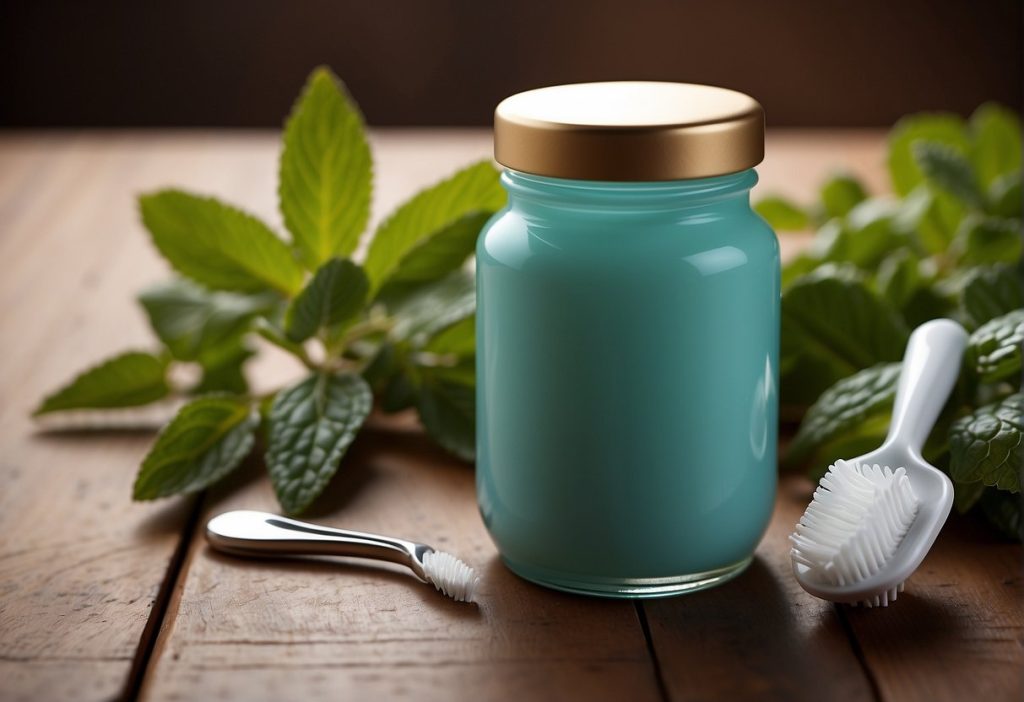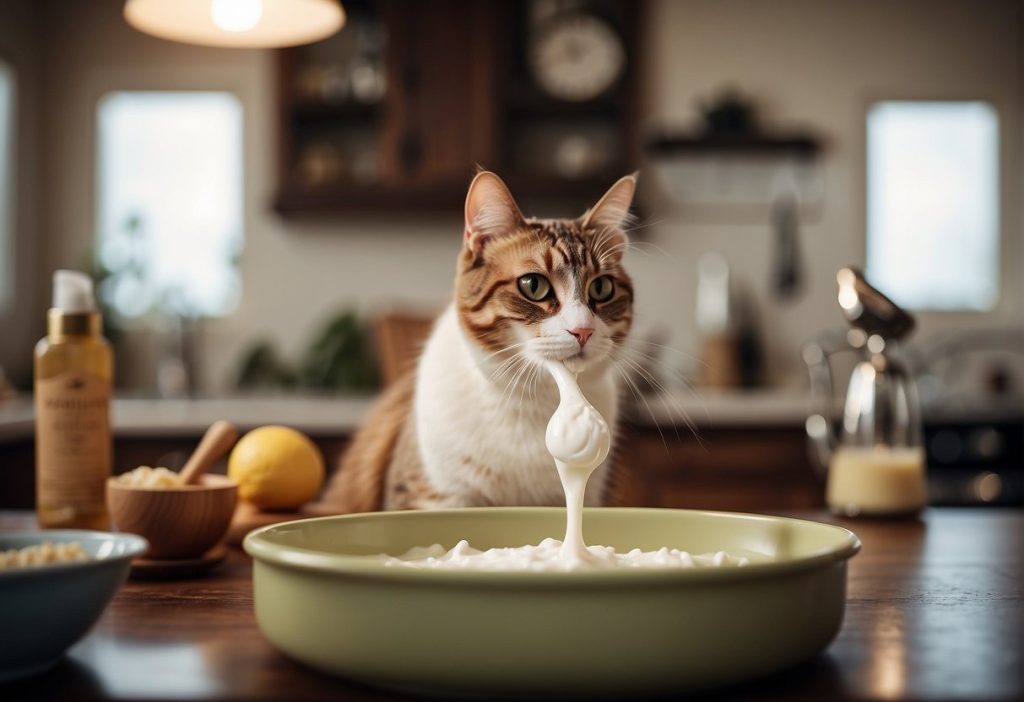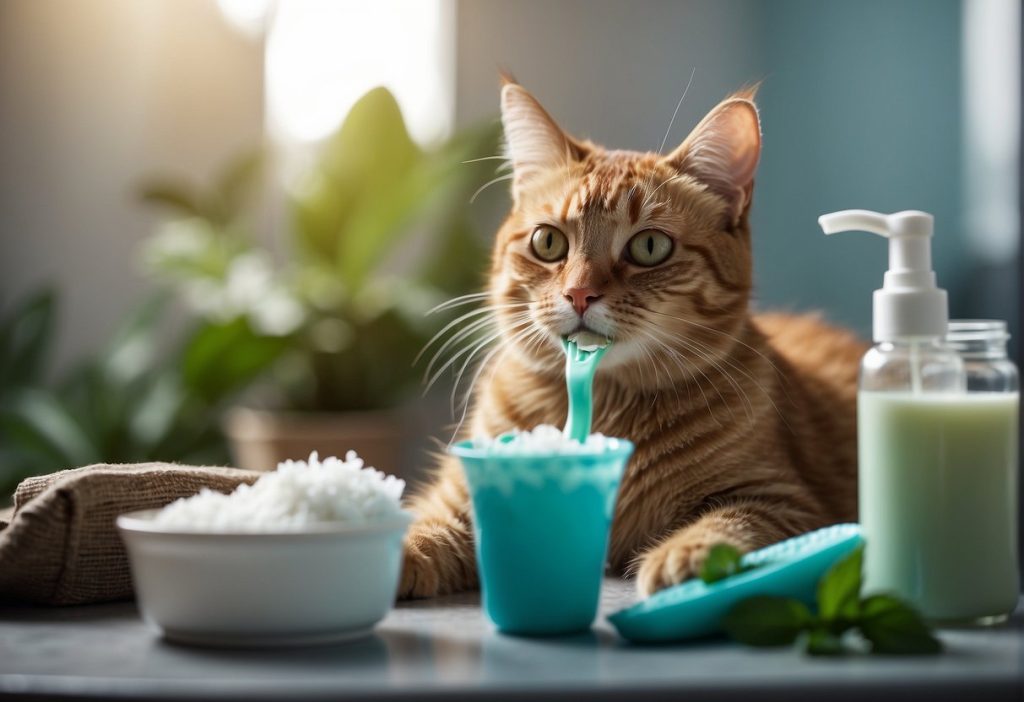Maintaining your cat’s dental health is as vital as caring for their fluffy coats and keeping their claws clipped. Just like humans, a cat can suffer from dental issues that can impact their overall well-being.
Have you noticed your feline friend’s less-than-pleasant breath lately?
It might be a sign that it’s time to focus on those pearly whites with regular teeth cleaning.
With the rise of DIY pet care, making your homemade cat toothpaste isn’t just a fun project, it’s a step toward ensuring your cat’s teeth stay clean and their gums healthy without the extra cost of store-bought products.
Plus, with homemade cat toothpaste, you can easily incorporate ingredients that promote teeth cleaning and fresh breath for your furry friend, including your cat’s teeth.
Regularly brushing your cat’s teeth with homemade cat toothpaste is key to their oral health, and with just a few ingredients you may already have, you can save money and trips to the store by making your cat toothpaste.

As pet parents, we’re always on the lookout for the best for our furry companions, and that includes their oral care.
A quick peek at the statistics would show a growing trend in tailoring pet care solutions ourselves.
Why? It gives us control over the ingredients, ensuring that our cats are exposed only to natural and safe components we trust.
Plus, who doesn’t love a good bonding session while whipping up a personalized concoction for our cats?
Coconut oil, a popular ingredient in commercial cat toothpaste, can be a great base for your homemade blend, appreciated for its cleaning properties and anti-inflammatory benefits.
You can even personalize the recipe with your pet’s favorite flavor, such as chicken bouillon or tuna, to make the experience more enjoyable for them.
For example, if your cat prefers tuna, you can easily incorporate it into the toothpaste recipe to make a delicious and effective toothpaste for your feline friend.
Key Takeaways
- Regular dental care is essential for feline health and homemade toothpaste offers a safe, customizable solution.
- DIY pet care, including toothpaste creation, is on the rise, with many cat owners opting for homemade alternatives.
- Natural ingredients like coconut oil are favored for their dental health benefits in cats.
What Are The Best Ingredients to Use for Homemade Cat Toothpaste?
Hey there, fellow feline fanatic! If you’re on the prowl for the purr-fect ingredients to whip up some homemade cat toothpaste, look no further.
Just grab your whisk, and let’s mix up a concoction that’ll make your kitty’s pearly whites twinkle!
Coconut Oil
A superstar in cat dental care, coconut oil is not only great for creating a paste-like consistency, but it also helps clean your kitty’s chompers.
Its lauric acid is known for its anti-inflammatory properties, and it’s gentle on your cat’s stomach too.
List of Must-Have Ingredients:
A natural cleaner with anti-inflammatory benefits.
Kelp:
This under-the-sea wonder can aid in reducing plaque. (1)
Turmeric
A dash of this spice isn’t just for lattes—it’s a natural anti-bacterial agent that can help keep those cat canines clear of tartar. But remember, moderation is key!
Ingredients to Use Sparingly:
Baking Soda
A smidgen can help clean, but too much might upset your cat’s tummy. (2)
Edible Calcium Montmorillonite Clay
Sounds fancy, right? It’s a soothing cleanser that’s kind to gum tissue and is effective in keeping diseases such as gingivitis at bay.
A Novel Ingredient with Neutral Flavor:
- Edible Calcium Montmorillonite Clay: A natural gum disease remedy. (3)
Creating your cat toothpaste can be a smile-saving affair! Just remember to introduce these new dental delights slowly.
Your kitty’s taste buds might need a little time to adjust to their new, tooth-tastic routine!
Personalized Recipes and Experiences

For the Kitten Connoisseur
Younger cats, or those with sensitive stomachs, might prefer a gentler touch. You might want to try a blend lean on ingredients:
- 1 part coconut oil (antibacterial)
- A pinch of turmeric (for a bit of color and health boost)
- A crush of catnip (for that irresistible allure)
For the Senior Savant:
Older cats could benefit from joint-friendly additives. A sprinkle of glucosamine to the base recipe helps. (4)
Ever heard the tale of George, the Siamese elder? His human swears by a dash of kelp in his toothpaste to keep his pearly whites in peak condition.
“A pea-sized dollop of this mixture, and George is ready for his close-up!” she beams.
DIY Enthusiast Tip:
Start a tooth-brushing routine slowly to turn it into a bonding experience. Remember, a little paste goes a long way.
| Ingredient | Purpose |
| Coconut Oil | Beef, chicken bouillon, or parsley for palatability |
| Flavoring(s) | Beef, chicken bouillon or parsley for palatability |
| Kelp | Contains minerals beneficial for dental health |
| Turmeric | Natural color, minimal health benefits |
In a nutshell, keeping your cat’s teeth clean with homemade toothpaste is a mix of practicality and personalized care.
It’s the concoction of choice for the health-conscious and budget-savvy pet parent. Just look at the purrs and bright smiles from the myriad of whiskered critters out there to know it’s worth the mix!
Plus, the slightly abrasive nature of homemade toothpaste can assist in plaque removal and lower acidity in the mouth to prevent cavities, while also hardening tooth enamel and improving bad breath.
With personalized recipes and experiences, you can cater to your cat’s specific dental needs and ensure their tooth enamel stays strong and healthy by eliminating toxins from their mouth.
By using natural ingredients such as calcium montmorillonite clay, you can also provide your cat with a complete mineral supplement and aid in toxin elimination.
Detailed Guide to Making Cat Toothpaste
Ingredients:
- Base: Coconut oil
- Flavorings: Beef or chicken bouillon, parsley (a pinch should do)
- Additional options: Kelp, turmeric (sparingly) (5)
Recipe 1: Coconut Delight
- Melt 1 tablespoon of coconut oil (antibacterial and fights plaque)
- Mix in ½ teaspoon of beef or chicken bouillon (for that irresistible taste)
- Add a pinch of parsley (for fresh breath!)
- Optional: A sprinkle of kelp or a tiny pinch of turmeric can be added for extra dental benefits
- Let the mixture cool and thicken
Instructions:
- Use a pea-sized amount
- Gently brush with a cat-friendly toothbrush or wrap gauze around your finger
Recipe 2: Baking Soda Blend
- Combine 1 teaspoon of baking soda (gently abrasive) with ½ teaspoon of water
- Stir into a paste consistency (if it’s too thick, just add a touch more water)
Troubleshooting Tips:
- If the paste is rejected, try adjusting the flavoring. Cats can be finicky, but they often can’t resist the taste of meat.
- Too runny? Add a bit more baking soda. Too thick? A little more water or coconut oil will do the trick.
Remember, introduce any new oral hygiene practice to your cat slowly. It’s all about making it a positive experience for them. Happy brushing!
Exploring the Nuances of Homemade Cat Toothpaste
It’s not as tricky as it sounds and can be a fun DIY project with great benefits for your feline friend’s dental health. Let’s dive in!
Ingredients Breakdown:
- Coconut Oil: The base for many recipes, coconut oil is loved for its ease of use and palatability.
- Baking Soda: Acts as an abrasive agent to help scrub away plaque.
- Mint Leaves: Freshens breathe without the sharp zing that peppermint can sometimes give.
Flavor & Preservation:
- A pinch of cat-friendly flavors like tuna or chicken broth can coax even the fussiest furball into a brushing routine.
- To prolong shelf life, store your mixture in the fridge in an airtight container.
Dental Perks:
- Regular brushing with your homemade formula can help ward off tartar and freshen your breath.
- However, it may not be as effective against existing dental conditions, so a vet visit is still a must for serious issues!
| Ingredient | Amount | Purpose | Notes |
| Coconut Oil | 1 cup | Base | Virgin and unrefined preferred |
| Baking Soda | 1 teaspoon | Abrasive | Gentle abrasive for plaque |
| Mint Leaves | To taste | Freshens Breath | Can be crushed or finely chopped |
Remember, while these ingredients are widely recommended, your kitty is unique.
Tailor your recipe to suit their tastes and needs. Happy brushing! 🐱🪥
Quick Recap

Benefits of Homemade Cat Toothpaste:
- Natural Ingredients:
Using items like virgin coconut oil means you know exactly what’s going into the mixture—no hidden nasties! - Cost-Effectiveness:
Whip up a batch without breaking the bank. - Pet Approval:
Mild flavors can make your kitty more cooperative at brushing time.
Key Considerations:
- Safety First:
Not all ingredients are cat-friendly—avoid baking soda in large quantities as it may upset your cat’s tummy. - Tailored Recipes:
Some recipes include anti-inflammatory agents like lauric acid, which is great for kitty gums.
Getting Started:
- Gather ingredients such as unrefined coconut oil.
- Consider flavor additions like crushed mint leaves—cats may prefer plain, but who knows?
- Get a soft toothbrush or gauze for application.
Remember:
- Start with a tiny dab to see how your cat reacts.
- Keep sessions short and sweet. You want this to be a treat, not a chore!
Eager to dive into the world of DIY cat toothpaste? Your cat’s health will thank you. Tackling tartar buildup has never been more tail-waggingly fun!
If you’re clawing for more info, there’s a treasure trove of resources and recipes online. Give it a go, and your cat’s chompers will shine bright like a feline diamond!
Don’t forget to incorporate Perio Support powder into your homemade toothpaste for extra cleaning benefits and reduced tartar buildup within 28 days!
Frequently Asked Questions
Crafting homemade cat toothpaste can be a safe, effective way to maintain your feline friend’s dental health.
In this section, we’ll tackle some of the most common questions to give you the confidence to get started.
Is homemade cat toothpaste safe and effective?
Absolutely! When made with the right ingredients, homemade cat toothpaste can be a safe alternative to store-bought brands.
Just be sure not to include anything toxic to cats and always consult with your vet beforehand.
What are the best ingredients to use in homemade cat toothpaste?
The best ingredients are those that are both safe for cats and beneficial for dental health.
Virgin coconut oil is a great base due to its lauric acid content, which has anti-inflammatory properties.
Avoid baking soda in large amounts as it can cause stomach upset in cats.
How often should I brush my cat’s teeth with homemade toothpaste?
For optimal dental health, aim to brush your cat’s teeth daily. Regular brushing helps prevent plaque buildup and maintains fresh breath.
Can homemade toothpaste help with specific dental issues in cats?
Homemade toothpaste can aid in general dental hygiene and may help with mild dental issues, but it’s not a cure-all.
Always consult your vet for advice on managing specific dental conditions.
How do I introduce my cat to tooth brushing?
Start slowly and be patient.
Let your cat sniff and taste the toothpaste, then gradually introduce brushing with a soft-bristled brush or finger brush.
What are the signs of dental problems in cats?
Keep an eye out for bad breath, difficulty eating, red or swollen gums, and visible tartar on the teeth.
These could signal dental issues that require professional veterinary care.
How can I store homemade cat toothpaste?
Store your homemade toothpaste in a small airtight container in the fridge to keep it fresh.
Typically, it should last for a few weeks when properly stored.


